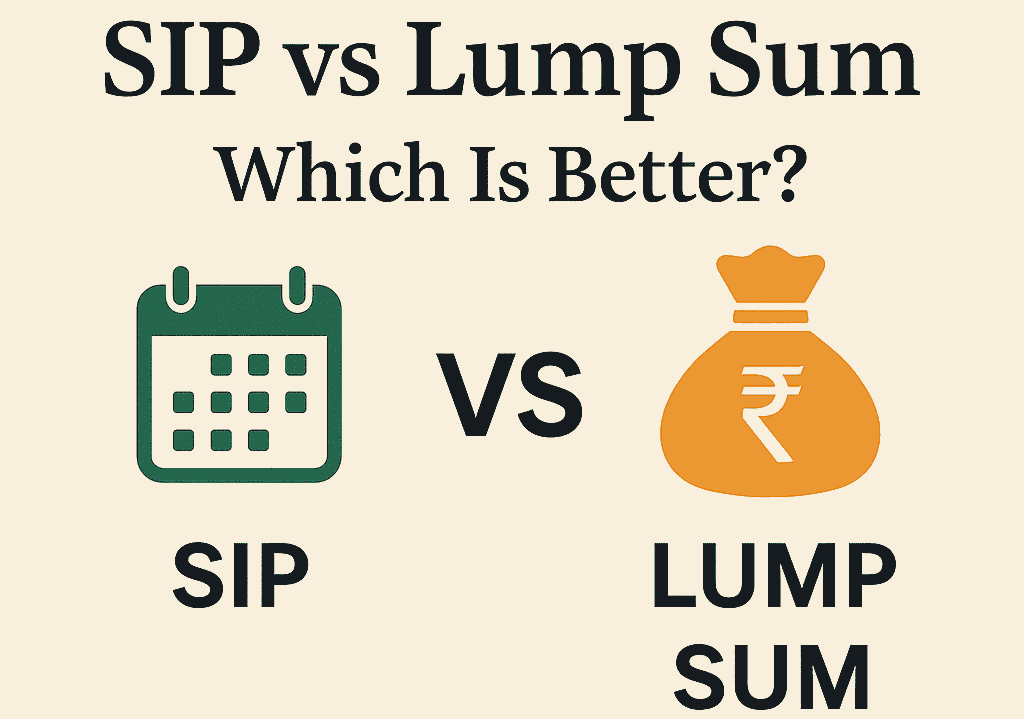Investing wisely is key to building wealth over time, but choosing the right mode of investment can be confusing. Two of the most popular strategies in mutual fund investments are SIP (Systematic Investment Plan) and Lump Sum investment.
Both have their pros and cons and suit different investor profiles. So, the million-rupee question is:
SIP vs Lump Sum: Which is better?
Let’s break it down in detail and help you decide what works best for you.
🔍 What is SIP?
A Systematic Investment Plan (SIP) allows you to invest a fixed amount at regular intervals—weekly, monthly, or quarterly—in mutual funds.
✅ Benefits of SIP:
- Rupee Cost Averaging: You buy more units when the market is down and fewer when it’s high, reducing the average cost per unit.
- Discipline & Habit: Encourages regular investing.
- No Need to Time the Market: Ideal for salaried individuals with steady income.
- Compounding Effect: Over the long term, even small contributions can grow substantially.
📌 Best For:
- First-time investors
- People with regular income (e.g., salaried professionals)
- Medium to long-term wealth creation
- Volatile markets
💰 What is Lump Sum Investment?
A Lump Sum investment is when you invest a large amount of money in one go.
✅ Benefits of Lump Sum:
- Immediate Deployment: Your money starts working for you instantly.
- Power of Compounding: More time in the market = more compounding.
- Suitable for Bullish Markets: If you expect the market to rise steadily, this can deliver higher returns.
📌 Best For:
- Investors with surplus cash (e.g., bonuses, inheritance, asset sale)
- Experienced investors
- When the market is undervalued (bearish phase)
📊 SIP vs Lump Sum: A Quick Comparison Table
| Feature | SIP | Lump Sum |
|---|---|---|
| Investment Mode | Regular, fixed intervals | One-time |
| Risk Management | Lower (averaging effect) | Higher (market timing risk) |
| Market Timing | Not required | Critical |
| Suitable for | Salaried, new investors | Seasoned investors |
| Flexibility | High | Low |
| Ideal Market Condition | Volatile or uncertain | Bullish or undervalued phase |
📈 Real-Life Example:
Imagine you have ₹1,20,000 to invest.
Option 1 – Lump Sum:
Invest the entire amount today. If the market performs well, you earn higher returns quickly. But if the market crashes tomorrow, your entire investment takes a hit.
Option 2 – SIP:
Invest ₹10,000 monthly for 12 months. Your investments are spread across market highs and lows, reducing risk and potentially increasing returns via rupee cost averaging.
🧠 Which Should You Choose?
Choose SIP if:
- You want to reduce risk
- You have a regular income
- You’re new to investing
- You want long-term discipline and habit
Choose Lump Sum if:
- You have a large amount ready to invest
- You can time the market (during dips)
- You understand risk and volatility
- You seek faster gains in bull markets
💡 Pro Tip: Hybrid Approach Works Too!
You don’t have to pick one over the other. Many investors follow a hybrid strategy—investing a part as a lump sum and the rest via SIP. You can even use STP (Systematic Transfer Plan) to invest a lump sum in a liquid fund and gradually transfer it to equity mutual funds.
🧾 Conclusion
There is no one-size-fits-all answer in the SIP vs Lump Sum debate. Your ideal choice depends on your income, risk appetite, market knowledge, and financial goals. SIP offers stability and discipline, while Lump Sum offers higher potential returns if timed well.
Always consult a qualified investment adviser to tailor the strategy for your personal financial situation.
🔍 FAQs
1. Is SIP safer than Lump Sum?
Yes, SIP generally carries lower risk due to market averaging.
2. Can I convert a Lump Sum into SIP?
Yes, you can park your funds in a liquid fund and use an STP to do this.
3. Which gives better returns – SIP or Lump Sum?
Lump Sum can give higher returns if timed perfectly, but SIP offers more consistent and risk-managed returns.
✍️ Written by:
Team FinancialAdviser.co.in
Your trusted guide for tax planning, investments & financial advice


